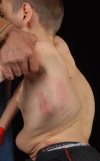Operative treatment for spinal deformities in cerebral palsy
- PMID: 24432105
- PMCID: PMC3838513
- DOI: 10.1007/s11832-013-0517-4
Operative treatment for spinal deformities in cerebral palsy
Abstract
The higher the functional impairment, the more likely patients with cerebral palsy (cP) are to develop a scoliotic deformity. This is usually long-sweeping, C-shaped, and progressive in nature, since the causes of the deformity, such as muscular weakness, imbalance, and osteoporosis, persist through adulthood. In contrast to idiopathic scoliosis, not only is the spine deformed, the patient is also sick. This multimorbidity warrants a multidisciplinary approach with close involvement of the caregivers from the beginning. Brace treatment is usually ineffective or intolerable in light of the mostly stiff and severe deformities and the poor nutritional status. The pros and cons of surgical correction need to weighed up when pelvic obliquity, subsequent loss of sitting balance, pressure sores, and pain due to impingement of the rib cage on the ileum become issues. General risks of, for example, pulmonary or urogenital infections, pulmonary failure, the need for a tracheostoma, permanent home ventilation, and death add to the particular surgery-related hazards, such as excessive bleeding, surgical site infections, pseudarthrosis, implant failure, and dural tears with leakage of cerebrospinal fluid. The overall complication rate averages around 25 %. From an orthopedic perspective, stiffness, marked deformities including sagittal profile disturbances and pelvic obliquity, as well as osteoporosis are the main challenges. In nonambulatory patients, long fusions from T2/T3 with forces distributed over all segments, low-profile anchors in areas of poor soft tissue coverage (sublaminar bands, wires), and strong lumbosacropelvic modern screw fixation in combination with meticulous fusion techniques (facetectomies, laminar decortication, use of local autologous bone) and hemostasis can be employed to keep the rate of surgical and implant-related complications at an acceptably low level. Excessive posterior release techniques, osteotomies, or even vertebrectomies in cases of very severe short-angled deformity mostly prevent anterior one- or two-stage releases. Despite improved operative techniques and implants with predictable and satisfactory deformity corrections, the comorbidities and quality-of-life related issues demand a thorough preoperative, multidisciplinary decision-making process that takes ethical and economic aspects into consideration.
Keywords: Cerebral palsy; Neuromuscular; Pelvic obliquity; Scoliosis; Sitting balance.
Figures


References
-
- Lonstein JE, Koop SE, Novachek TF, et al. Results and complications following spinal fusion for neuromuscular scoliosis in cerebral palsy and static encephalopathy using Luque–Galveston instrumentation: experience in 93 patients. Spine (Phila Pa 1976) 2012;37(7):583–591. doi: 10.1097/BRS.0b013e318225ebd5. - DOI - PubMed
-
- White AA, 3rd, Panjabi MM. The clinical biomechanics of scoliosis. Clin Orthop Relat Res. 1976;118:100–112. - PubMed
-
- Watanabe K, Lenke LG, Daubs MD et al (2009) Is spine deformity surgery in patients with spastic cerebral palsy truly beneficial? A patient/parent evaluation. Spine (Phila Pa 1976) 34:2222–2232 - PubMed
Publication types
LinkOut - more resources
Full Text Sources
Other Literature Sources
Miscellaneous

